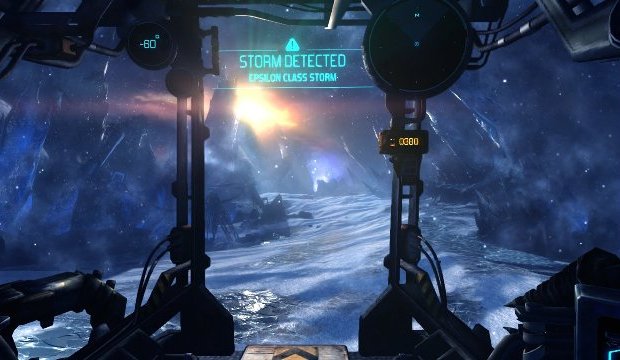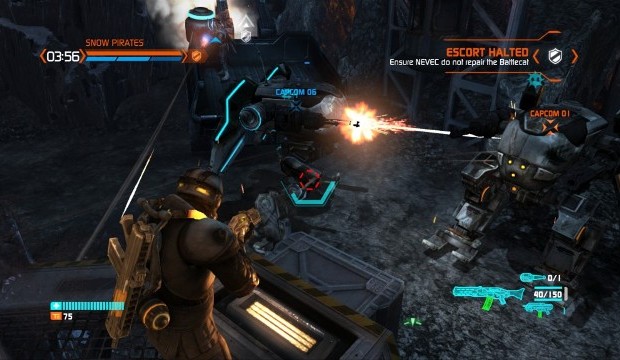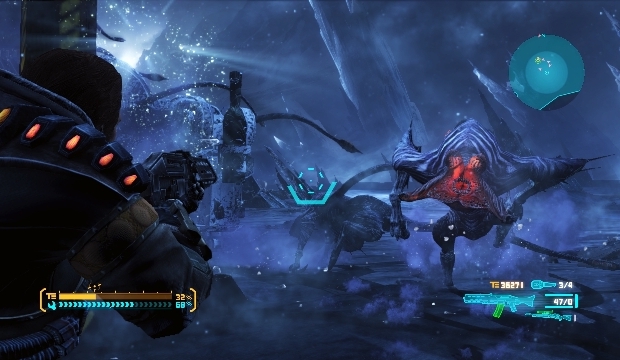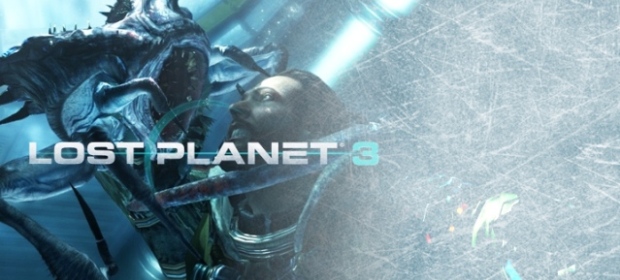Despite being the third title in the series, Lost Planet 3 is refreshing in the sense that it completely tears up the franchise rule book and carves out its own identity as a game. Of course, that doesn’t necessarily mean that it is all for the better, but with the series no longer under in-house development in Japan, American studio Spark Unlimited have seized the opportunity to re-launch Lost Planet as a very different proposition to what came before with a radical new prequel.
It still takes place on E.D.N III like the first and second game, but rather than the base at Coronis being an established colony you now control Jim Peyton, a contractor who has taken up the opportunity to be among the first humans to explore the planet and earn some big money at the same time. You work for a mining company who is backed by NEVEC (the Neo-Venus Construction Company), who were previously the main antagonists in the series. At this point in the past, however, they seem innocent enough, but you will start to learn more and more troubling information as the story unfolds.

Lost Planet 3 focuses much more heavily on both story and character development than either of the previous games did. The first game was more story-centric than the second, but this third entry really places plot above and beyond the action – giving it a very cinematic feel at times. You can certainly see the Western storytelling influence in this regard and it does lead to the story being more interesting than in previous efforts. The main character Jim is very likeable; he jokes around, helps out those in need and does it all with a strange knack for remaining un-fazed.
The whole time whilst we are exploring the planet and learning the grim history behind the expedition, there is a background love story between Jim and his wife back on Earth – played out in video messages between missions. These really help you connect to Jim and see his motivations – and it helps him develop. In fact the character development overall in the game is good, whereby you can talk with NPCs and other significant figures when you like – similar to an RPG – and get different conversations as you progress through the game. The whole cast is a varied and interesting bunch – not just your usual action movie stereotypes.
Some players will likely be put off by the slower pace that results from such a story-heavy title. The decision to focus on narrative and character development does mean a more meandering pace, and as a result the game takes a long time to get going. Those expecting the action-packed missions of Lost Planet 2 will be disappointed, as this game is much more about peaks and troughs – periods of calm and build-up, punctuated by intense action scenes. This isn’t helped by the fact that there is a lot of backtracking involved – moving from one area to another can take a very long time and you often feel like you’re just re-treading the same ground. Thankfully, a fast travel system does unlock, but not until you’re a good way through the story.

The game is primarily a third-person cover shooter. You can duck behind objects in the environment and dodge and roll from attacks, whilst quickly throwing out grenades and switching between your equipped guns. It isn’t a bad shooting system – lacking some of the refinements of a dedicated FPS, but providing a surprisingly solid experience. Firefights are often punctuated by Quicktime Events, such as needing to tap a button to hold back an enemy or quickly aim a knife blow for a close-range kill, particularly during the battles with some of the truly massive bosses.
The game switches to a first person perspective when you get in your Rig, which is the new replacement for the bots that featured so heavily in the previous titles. Rather than Military Anime-style bots, your Rig is meant simply as a practical tool – with no weapons as standard. You start off only with a claw and a drill, which are both intended for mining work, although they come in handy for dealing with the local wildlife, too. Being set in the past, with old technology, your Rig is slow and lumbering – a far cry from the frantic battles seen previously, and it isn’t really that formidable in a fight. As the game wears on, you will gain new tools for your Rig and also have the chance to buy upgrades.
Currency in Lost Planet 3 is known as Thermal Energy, and is found in the ground and the creatures of E.D.N. III. By drilling the land and killing enemies, you can gather this energy, which then acts as money for buying new weapons, ammo and upgrades. There is a good range of weapons to buy and you can pick and choose what to customise depending on your weapons of choice. Your main cannon fodder are the insect-like Akrid, which luckily have glowing weakpoints and set attack patterns to make things easier. Learn these and you won’t often have too much difficulty defeating them. Many battles tend to feel the same and even boss fights all share a similar structure – so unfortunately some of the action scenes don’t pack the punch that they perhaps should.
Aside from completing the story missions, there are a plethora of side quests and activities to partake in, which will help swell your wallet. These can slow down the pace of the game even further and keep you from progressing the story, but they are optional, meaning that to an extent, you can dictate how you tackle the game. These missions include making repairs to company machinery, taking DNA samples of the local species or defending your Rig as it drills for Thermal Energy.
Strangely though, almost all of these seemingly routine tasks result in killing tens or hundreds of Akrid – but due to the fact that there isn’t a huge variety of Akrid species, the quests all tend to feel very similar. The game is padded out further by several collectables such as audio and text logs, which, although fairly unimaginative, will reward you with Achievements whilst also fleshing out the backstory with little chunks of information. With all of the side quests, collectables and story missions, the game is pretty hefty and isn’t the kind of thing that you will rush through in no time. It would be a lot quicker without the backtracking, but it remains lengthy nonetheless.
It must be said that Lost Planet 3 is a pretty good-looking title. This may be aided by the fact that much of the game takes place under cover of heavy snowfall and fog, but the vistas are pretty spectacular, the Rigs and ships impressive and the character models actually very detailed. This shows more prominently in cutscenes, where the facial details of core characters are of a very high quality and full of personality – despite the fact that Jim bears an uncanny likeness to Nicholas Cage (we won’t begrudge him that). The weather effects do a great job of creating the lonely, isolated atmosphere and, when combined with the dramatic lighting effects, also portray a mood of foreboding, that something isn’t quite right in Coronis.

There are minor issues such as text appearing far too small to be comfortably read at times, and the fact that the white text can be hard to read if you are facing a snowy background – because the background shows through the text when reading a note, for example. This is annoying, but is hardly a massive complaint. The music is an amusing mix: the atmospheric music is very obviously inspired by films such as Alien, and fits the mood of the scarier scenes perfectly, but you also have a kind of CD soundtrack that plays when you are exploring in your Rig. This is heavy on the Spaghetti Western-style music, which, especially when coupled with the theme of surviving in a harsh atmosphere, evokes memories of Firefly. In a nice touch, you can even load your own albums for playing in-game.
With the main game being so story-centric, you might expect something equally deep from the multiplayer. If so, that was wishful thinking, as the modes are all fairly standard. There are four modes of play: Team Deathmatch – a 5-on-5 mode which speaks for itself; Extraction, where two teams must plant Therma posts and mine more energy than the other team; Scenario, which is objective-based with one team trying to complete tasks such as arming bombs whilst the other team tries to stop them; and Akrid Survival.
In this final mode, two teams of three face off against waves of Akrid. You must work fast, however, as once all the Akrid are defeated your team can try to take control of energy points while eliminating the other team. Whilst the other three modes are really standard, Survival tries something different – but the problem is that once one team has defeated their Akrid and taken over a control point, it is almost impossible for the other team to make a comeback. The balancing needed to be a little better here – so make sure you are fast. The modes are all fine, but they don’t really tie in with the single-player experience, and as a result they all feel a bit tacked-on. With such a large main campaign, they were hardly necessary and are by no means as much fun as the popular multiplayer modes in Lost Planet 2.

VERDICT: If you were a fan of the Lost Planet series already, there is a good chance that you won’t like Lost Planet 3 very much at all. Mechs are reduced to a mere sideline – mainly a form of transport – for this game, with most of the action taking place on foot. In that respect, the game is missing the unique identity that made the franchise stand out. There also isn’t nearly as much action as fans might be used to. However, the measured pace and involving storyline might well attract a whole new audience to the game, who are looking for a different gameplay experience.
It is a much more considered title and as such doesn’t provide instant gratification or quick fire kills, but it does make you connect with the characters and make you care about what happens. The slow-burning start betrays a really engrossing game, let-down only by its rather repetitive firefights and laborious backtracking. The multiplayer also really does nothing to add to the whole package, which is another disappointment. With a little more polish it could have become a really great title, nevertheless if you put in the time and have patience this is one game that doesn’t deserve to remain lost in the frozen tundra.

GOOD. A game that scores 7/10 is worthy of note, but unworthy of fanfare. It does many things well, but only a few of them incredibly well and, despite a handful of good qualities, fresh ideas and solid mechanics, it fails to overwhelm.







